Verdict
Elden Ring Nightreign shoots for the stars with a clean retrofit of familiar assets into a roguelike format, but it’s dragged back down to earth with repetitive encounters, overtuned bosses, and lacklustre meta-progression. Random chance and an urgent pace rewards blind haste over careful buildcraft, but I'm confident its biggest issues can still be fixed.
"Summon one another as spirits, cross the gaps between worlds, and engage in jolly cooperation." The immortal words of Solaire of Astora have echoed across FromSoftware's Souls series and beyond. It's a rallying cry to band together during adversity; a reminder that, no matter how impossible a challenge, the wider community is just a summon sign away. Until Elden Ring Nightreign, its multiplayer elements have historically amounted to transient encounters with strangers that either help or harm.
These morsels of player interaction have fostered a healthy appetite for dedicated co-op within the Dark Souls, Bloodborne, and Elden Ring communities. We've seen this appetite manifest in co-op game. Sort of.

It's Limgrave, Tarnished, but not as we know it. The familiar trail that leads a freshly-woken player to Stormveil Castle in Elden Ring is no more. Or rather, it's yet to be. Instead, Nightreign's Limveld is a blank canvas filled with an ever-shifting assortment of churches, ruins, camps, and evergaols. In future runs, this landscape is made even more hostile by volcanic eruptions and rot-infested woods. This is The Lands Between in the apocalyptic aftermath of the Shattering, ravaged by heavy rains and the oppressive night itself.
FromSoftware's worlds all have a cyclical nature, each one an iterative rumination on the cycle of life, death, decay, and rebirth. Compare this to the core roguelike game loop, and the idea of a genre spin-off quickly progresses from a possibility to an inevitability. Each run is divided into three days. The first two days consist of exploration followed by a boss, while the final day is dedicated entirely to a showdown against the Nightlord avatar chosen at the beginning of your run. A Fortnite-esque circle of blue flame is a menacing shepherd that herds Nightfarers to those boss encounters.
As it stands, this circle comes in far too quickly. You have about five minutes at the start of a run before the circle contracts, cutting off access to the wider area in just three minutes. Another five minutes to explore this restricted zone, and then it starts to contract again, with a further three minutes to finish up preparations before day one's boss. Defeat it, and the circle resets for you to do it all over again. This means that the exploration section of a run takes around half an hour. Factor in the additional time to beat the three major boss encounters, and a full Nightreign run can take anywhere between 45 minutes and over an hour. It's slightly longer than the average roguelike run, yet between its online multiplayer and invisible timers, it demands a much faster pace.
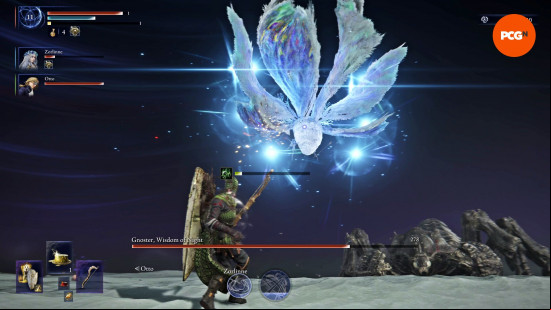
The eight Nightreign classes broadly conform to standard archetypes in both Elden Ring and party-based RPGs. Meaty tanks and armored swordsmen stand shoulder to shoulder with spell-slinging sorcerers and nimble rogues. The function of each class is so recognizable that it lends them all a pick-up-and-play quality, but steeper learning curves lurk in the depths of their character skills. I'm also impressed with the unconventional direction FromSoftware has taken with some of these skills. The Duchess totes around a damage-doubling pocket watch and an invisibility cloak, setting her apart from the thief builds that came before her.
Unfortunately, the Executor stands out as a class ill-suited for a multiplayer experience. A character built on deflections and poise breaks is as emblematic to the FromSoftware experience as they come (and, incidentally, my favourite way to play). However, the ability to read and respond to attack patterns is a tall order when allies continuously interrupt animations and obstruct the view. Conversely, the Revenant is a marvel. Given that a summoner build is close to unviable in Elden Ring, I approached this class with the most skepticism. Sebastian, her giant skeleton companion, exceeded all my expectations.
The swiftest Nightfarer dictates the pace of the run, which typically corresponds to the player with the most confidence. This isn't much of a problem when all players are at the same experience level, but whenever there is a meaningful disparity, the weakest can quickly get left behind. Odds are, this won't be too much of an issue at launch when everyone is in the same boat sailing into the unknown; give it a few weeks, and it's liable to become a veritable trial-by-fire for latecomers with no dedicated group.
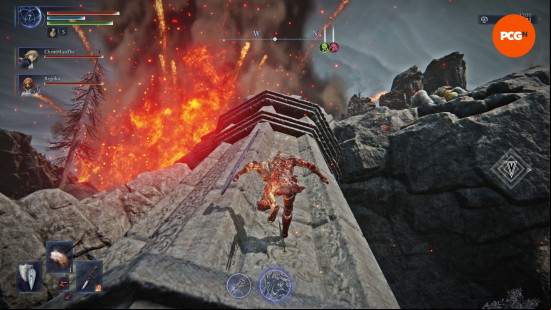
If you're one such player, you might consider Nightreign's solo mode a good way to cut your teeth before matchmaking, but honestly, I wouldn't recommend it. While enemies are scaled down just enough to facilitate a challenging but manageable single-player experience, you've still only got five minutes before the circle starts to move inwards – the same amount of time as a three-player group. My solo experience in Nightreign can be represented in a procession of half-beaten bosses, begrudgingly abandoned in the face of an oncoming blue ring of death.
Sure, solo is technically possible if the stars align. However, with no one else on hand, it takes longer to clear points of interest, which in turn creates fewer loot drops. Throw in a few dud weapons, and a solo run is all too easily doomed before it's even begun. If you're a total novice, you're far better off just plunging in at the deep end and letting your strongest allies carry you until you can keep your head above water. Even so, this doesn't make for an enjoyable experience for anyone involved; the veteran is forced to pull double duty, while the novice is reduced to a burden.
The exclusion of duo teams is by far FromSoftware's biggest misstep here. Three's not exactly a crowd, but it is a colossal pain in the ass if you're all adults with busy schedules. This is easily solved with an AI companion or two, but right now, two players must be prepared to depart with any random player the matchmaking system deigns to spit out. Like Elden Ring before it, Nightreign doesn't include integrated voice or text chat. There's an argument to be made here that this is for the best – consider how tilted some soulslike fans get when they lose to a boss, then raise the stakes and introduce the ability to blame someone else. It's hardly a recipe for polite conversation.
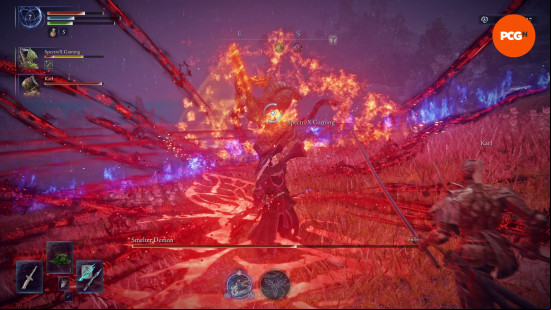
Nevertheless, direct communication has never been more important for a FromSoftware RPG than it is in Nightreign. Whether it's careful coordination of class synergies or attempts at boss strategies, there's a lot that's left on the table when you omit voice chat. Combat aside, with such limited time before the circle closes in, you don't want to spend precious seconds quibbling over where to go next, nor do you want allies striking out on their own. There's little nuance in plopping down a marker and hoping your fellow Nightfarers follow your lead, but without the luxury of an external voice call, that's all you have to hand.
Thankfully, the height of this hurdle is lowered substantially if you're thrown in with experienced players. This is largely because there's no deep strategy involved in navigating Nightreign's map; the best objective is almost always the closest, with some notable exceptions. Churches offer disproportionately high value thanks to the additional healing flasks within, and evergaols are a must-visit if a key drops. Overall, though, travel time is lost time, and the best way to minimize it is to reach the closest point of interest as fast as possible.
Nightreign introduces some delicious tension on day two with spawn points for the most formidable field bosses. This is where the social fabric most often begins to fray, as underleveled but overconfident teammates opt to throw themselves into what amounts to a brick wall, losing precious time and levels. It's the kind of pitfall that can only entice a core audience raised on overcoming challenges to 'git gud,' but in the context of Nightreign, this tunnel vision is a silent killer. However, it doesn't take long to get a general sense of what level you need to be at for all of Nightreign's challenges; eventually, the cadence of each run becomes rote, and the grind behind day one and two gradually reveals itself.
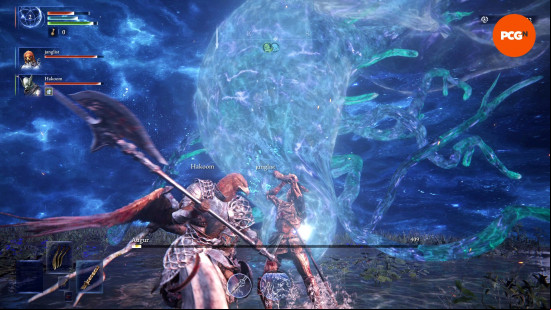
Perhaps this grind would be easier to bear if there's a possibility of success at the end of it, but that's a hope that rests on luck as much as it does skill. Right now, the Nightlords are undeniably overtuned. Their massive health pools ensure that whatever degree of power you've amassed throughout a run is reduced to chip damage. Sure, Nightlords represent the toughest challenge that Nightreign has to offer. Still, it's no less disheartening to go from tearing through regular bosses in moments to barely making a dent at the culmination of all your best efforts. Doubtless, this is an overcorrection following complaints that Nightreign's inaugural Nightlord went down too easily in the beta. Thankfully, FromSoftware is no stranger to a boss nerf or two; if it's prepared to topple Elden Ring's Radahn from his pedestal, I expect it to treat Nightreign's Nightlords with a firm hand.
Ostensibly, each Nightlord comes with its own set of gimmicks, whether that be attacks to disrupt or weaknesses to exploit. Gimmicks aren't inherently bad, but they can also become an exercise in frustration and a slow but certain death. Take Maris, Fathom of Night. This soporific jellyfish drifts through the atmosphere, often beyond the reach of melee classes, continually putting everyone to sleep and dealing damage over time. It's a war of attrition where death is inevitable once you run out of healing flasks. It's also a complete pushover once you understand how to interrupt its effects. Traditionally, even the most truncated boss encounter provides a sliver of knowledge bringing you one step closer to victory. Now imagine the most annoying bonfire-to-boss run you've ever taken in Dark Souls, then extend it to an hour and reroll all your stuff. That's Nightreign.
Look, I don't expect FromSoftware to deliver me a win on a silver platter. I'd be disappointed if it did. However, in its efforts to preserve Elden Ring's legacy as a challenging experience, it's neglected to for the satisfaction that comes from a successful roguelike. A victory in a roguelike, hard-won as it should be, is not the end. Nevertheless, the impervious nature of Nightreign's Nightlords betrays a fear that, once beaten, players will never return.

FromSoftware has one hell of a boss pool to pull from, but even with Dark Souls' Nameless King and Gaping Dragon on retainer, I still find myself running into the same bosses again and again. A surprise invasion by Margit-slash-Morgott put a smile on my face, but frankly, I'm bored of dealing with Wormface and his Death Blight vomit. Sure, his constant reappearance is just a case of unlucky RNG, but I feel much the same about the Royal Army Knights, Erdtree Burial Watchdogs, and Oracle Envoys – bosses I've fought multiple times in a single run, and offered little challenge besides.
That brings me to my next major bugbear, which is FromSoftware's boss curation. I can only hope this pool expands, because at the moment, encounters are overwhelmingly suited for ranged classes over melee. The argument here is that every class would do well to pick up a ranged weapon to keep on standby, but it seems counterproductive to drop into Limveld as a close-range fighter and then weather a whole boss fight circle-strafing with a bow.
Nightreign goes against the ethos that FromSoftware has invariably followed since 2009. Demon's Souls, Dark Souls, Bloodborne, Sekiro, Elden Ring – all of them are punishing at times, but all give you the tools to succeed. Nightreign's variability, an inheritance of the genre it seeks to emulate, often withholds those tools. Instead, the player is forced to work with what luck provides, and it can be far crueller than anything FromSoftware can cook up. If the tools you amass aren't enough to succeed, well, better luck next time. Literally.
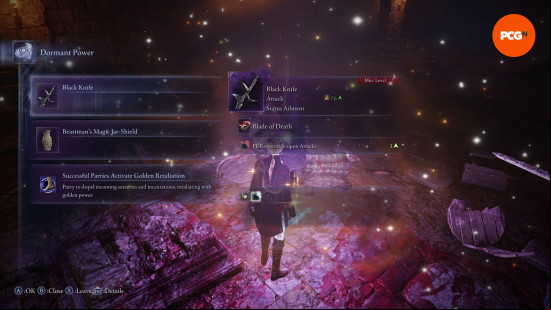
Nevertheless, there is a silver lining to this cloud. Nightreign suspends weapon stat restrictions that are necessarily prohibitive in Elden Ring, which in turn opens the door for experimentation. I've wielded weapons that never would have justified a respec in Elden Ring, partly out of pure desperation to improve my loadout in Nightreign.
Unfortunately, the consolation prize for a failed run is often cold comfort: a selection of relics with randomly generated ives. These esoteric objects, arranged in vessels between runs, form the backbone of Nightregin's meta-progression. With a few notable exceptions, luck holds court over these treasures. Relics offering multiple ives that are appropriate for one class are a blessing, but they're also exceedingly rare. As it stands, my inventory is cluttered with relics that provide low-value consumables and buffs for weapons with status effects that have no guarantee of dropping during a run.
Again, there are some exceptions. The most obvious is the gacha-esque offerings of the Small Jar Bazaar, which spits out even more random relics to gather dust in my inventory. The set relics rewarded during Remembrances are a far better alternative. These character-specific scenarios invite insight into the Nightfarers themselves. Nightreign's writing lacks the prosodic quality of its predecessors. FromSoftware's obfuscation of story and dialogue has become as intrinsic to soulslikes as the souls themselves, but the Remembrance storylines are startlingly clear-cut. Unfortunately, the steps to complete them often involve venturing into Limveld with a singular goal, which can upset the expedition flow for the rest of your team.
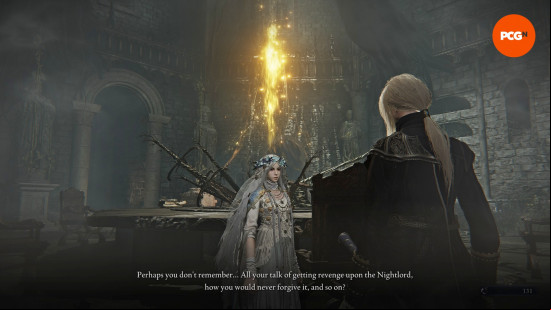
Nightreign's myriad problems hamstring the experience it's trying to deliver, but there's no doubt that when it works, it really works. As low as its lows get, they're eclipsed by the high that's familiar to any soulslike enjoyer: the percussive thud of a stance broken; the adrenaline rush of landing a killing blow. These moments, hereditary to the single-player games that came before it, are positively euphoric with an audience to witness them. The compulsion towards 'one more run' waxes and wanes, but its existence alone proves that there is something in this roguelike.
I have to give credit where it's due. Nightreign is a clever way to reuse a rich library of well-crafted and beloved assets to chart new paths for a game studio that's already paved the way for countless others. However, the cynic in me can't help but wonder whether Nightreign is a glorified test run for The Duskbloods, Miyazaki's multiplayer exclusive for the Switch 2. Perhaps Nightreign's lower price point can take the sting out of that suspicion, as can director Junya Ishizaki's vow that it won't be beset by microtransactions later down the line.
One question lingers. Who is Nightreign's target audience? I don't think it's me, but if not me, then who? It's certainly not for complete beginners, who must muddle through the intricacies of weapon arts, guard counters, and established boss strategies before they can even reckon with Nightreign's unique elements. I'm not sure if Elden Ring's 99th percentile will find long-term satisfaction in Nightreign's minimalist structure either. Regardless, whatever audience it does amass will still have to temper high expectations. The good news is that I'm confident Nightreign's biggest issues can and will be fixed. Until then, I'd rather be playing Elden Ring.
